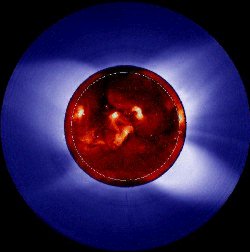Click on image for full size
Image courtesy NASA (modified by Windows to the Universe staff).
History of Sunspot Observations
You may not know that humans have observed sunspots for a very long time. These records have been around so long in fact, that we can link sunspot number with solar activity. Large sunspots can sometimes be seen with just your eye, especially when the Sun is viewed through fog near the horizon at sunrise or sunset. (WARNING: Never look directly at the Sun! Even a brief glance can damage your eyes!)
The first written record of sunspots was made by Chinese astronomers around 800 B.C. Court astrologers in ancient China and Korea, who believed sunspots foretold important events, kept records off and on of sunspots for hundred of years. An English monk named John of Worcester made the first drawing of sunspots in December 1128.
Soon after the invention of the telescope, several astronomers used the telescope to make observations of sunspots. This was around 1600. Astronomers of that time weren't quite sure what to make of these spots on the Sun. Some thought they were shadows of undiscovered planets crossing the Sun, while others believed they were dark clouds in the Sun's atmosphere. The movement of sunspots across the face of the Sun allowed astronomers in the early 1600's to make the first estimates of the Sun's rotation period (about 27 days).
In 1843 an amateur German astronomer named Samuel Schwabe discovered the rise and fall of yearly sunspot counts we now call the sunspot cycle. He first guessed the cycle's length at 10 years. Two French physicists, Louis Fizeau and Léon Foucault, took the first photo of the Sun and sunspots in April 1845. Around 1852 four astronomers noted that the period of the sunspot cycle was identical to the period of changes of geomagnetic activity at Earth, giving birth to the study of Sun-Earth connections we now call "space weather".
It would appear that sunspots not only have a connection to geomagnetic activity at Earth, but they play a role in climate change as well. In the last thousands of years, there have been many periods where there were not many sunspots found on the Sun. The most famous is a period from about 1645 to 1715, called the Maunder Minimum. This period corresponds to the middle of a series of exceptionally cold winters throughout Europe known as the Little Ice Age. Scientists still debate whether decreased solar activity helped cause the Little Ice Age, or if the cold snap happen to occur around the same time as the Maunder Minimum. In contrast, a period called the Medieval Maximum, which lasted from 1100 to 1250, apparently had higher levels of sunspots and associated solar activity. This time coincides (at least partially) with a period of warmer climates on Earth called the Medieval Warm Period. Sunspot counts have been higher than usual since around 1900, which has led some scientists to call the time we are in now the Modern Maximum.














